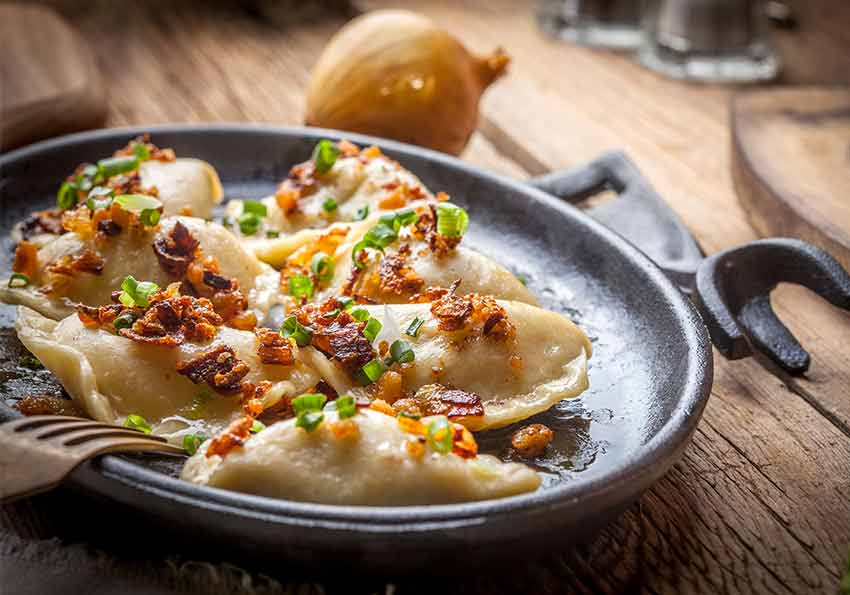Pierogi – what are they? What is a recipe for pierogi? That is everything you should know about pierogi
Once upon a time in a faraway land there was a country where pierogi were one of the most popular dishes… This is how the tale about Poland could begin. Yes, it is here that you will eat the best pierogi in the world. Italians have pizzerias, Spaniards tapas bars and Poles have pierogarnias (bars selling pierogi). Once you taste pierogi, you will always love them.

What are pierogi
Pierogi are one of the traditional Polish dishes. They are prepared from boiled, baked or fried dough stuffed with a filling. Pierogi have their own legend. It is said that in the 13th century, Bishop Jacek Odrowąż admired their taste during his stay in Kiev. Together with other souvenirs from his journey, he brought back to Poland the recipe and thus started a centuries-old tradition of eating pierogi, which continues to this day.
Before pierogi found their way into every Polish home, for a long time they were treated as a festive and special dish. They were served only on a special occasion – at feasts, weddings, and funerals. With time, they became a very frequent guest on the Polish tables, and they are still triumphant today.
Pierogi making
In many households, making pierogi is a tradition. The whole family gathers around the table and cuts out circles or rectangles from the prepared dough (depending on the type of dumplings), lays the filling on them, and then – and this is the strategic point of the whole operation – glues the edges of the dough together to form the dumplings. Some people even decorate the edges of the glued dumplings fancifully with a fork or arrange the edges in the shape of a frill.
We have plenty of pierogi
In principle, it can be said that pierogi provide unlimited scope for experiments in cooking. Dough can be made from wheat, spelt, rye or corn flour, and butter, oil or olive oil can be added. Pierogi can be eaten sweet or salty, stuffed with chocolate, fruit, meat, mushrooms and vegetables. They can be boiled, fried, baked and grilled. They can be as small as borscht ravioli or served in slices due to their large size.
What is the most important thing if you want dumplings to be successful? First of all, the dough! Without a good dough, the dumplings will not stick together properly and will fall apart during cooking. The dough must be shiny, springy and not stick to your hands. Secondly, the stuffing! What you stuff the dumplings with will give them character. You need sweetness – choose dumplings with cheese and strawberries. Fancy something more substantial? Try the ones with duck or bacon. Prefer a vegetarian version – try the ones stuffed with spinach. Do you like to experiment? Prepare dumplings with smoked tofu or salmon.
Fifty faces of pierogi
Since Poland is famous for its pierogi, you can choose from dozens of species and subspecies of this dish. We will present you the most classic ones. Here is the Polish pierogi canon.
- Ruskie („Russian”). Let us explain right away that Ruskie pierogi do not come from Russia at all, but from the Red Ruthenia (Kresy Wschodnie). They are one of the favourite Polish dumplings, and the secret of their taste lies in the stuffing made of cottage cheese, boiled potatoes and onion glazed on a frying pan.
- With strawberries. Suitable both for dinner and for dessert. Put in a delicious dough, the sweet, red fruits will go from your plate straight to the list of your favourite dishes.
- With berries. A holiday dish that tastes best with berries you have picked yourself in the forest.
- With cabbage and mushrooms. No Christmas without them! It is one of the twelve traditional Christmas Eve dishes.
- Uszka. Tiny dumplings with a mushroom filling which are served with Christmas Eve borscht.
- With cheese. This is a classic stuffed with cottage cheese. You can prepare them sweet or salty – depending on the spices you add to the stuffing.
- Leniwe. Why „lazy”? Because they have no filling. You simply add cottage cheese to classic dough, mix, form dumplings and cook. This is a quick and effortless way to make leniwe pierogi „lazy dumplings”.
Recipe for pierogi by grandma Marta
Pierogi recipes are plentiful, and many families have their own secret recipe passed down from generation to generation. We will tell you the recipe of Grandma Marta, who worked as a cook for over forty years. It's a recipe for pierogi cooked in water.
Shopping list
- 0,5 kg wheat flour,
- 2 eggs,
- 4 tbsp oil,
- 1 heaped teaspoon of salt,
- 150–200 ml hot water (not boiling water!).
What you need to do
Sift the flour into a large bowl. Add salt, oil and eggs. Mix, gradually adding hot water. Knead the dough into a smooth mass until it no longer sticks to your hand. Grandma Marta said it should take at least ten minutes.
Cover the ready dough and set it aside for about a quarter of an hour. When the dough has rested, tear off a piece and roll it out to a thickness of a few millimetres. Keep the rest of the dough covered! Cut out round slices with a glass. Put the filling on them and stick the edges together. You can use a pierogi maker, but your fingers or a fork will work just as well.
Drop pierogi into slightly salted, boiling water. When the water comes back to a boil, cook the dumplings for about two minutes after they float to the surface. Gently take them out with a strainer onto a plate and then enjoy the dish!
Pierogi with fruit go well with yoghurt or thick cream. For more sophisticated pierogi with meat, spinach or mushrooms, sprinkle them with mozzarella. Those with white cottage cheese were served with sugar by Grandma Marta and were always the best dinner.
The global career of pierogi
Pierogi have gained a lot of fans also outside Poland. The dish is promoted especially by the Polish community in the United States. American pierogi fans celebrate National Pierogi Day on October 8th. They celebrate that day by visiting restaurants which serve the dish. One of them is Pierogi Mountain, a very popular pierogi restaurant located in Columbus, Ohio. You can also eat Polish pierogi in Brazil, Germany or New Zealand. Their triumphal march continues.
What are your favourite pierogi? Share your opinion with us in the comments. Haven't you tried them yet? It is high time to catch up. Enjoy the meal!





